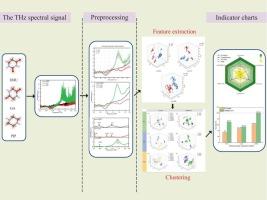用太赫兹光谱法高精度鉴定二氢脲嘧啶、甘氨酸酸酐和哌嗪
IF 3.4
3区 物理与天体物理
Q2 INSTRUMENTS & INSTRUMENTATION
引用次数: 0
摘要
区分结构相似的药物化合物仍然是药品质量保证的一个重大挑战,特别是当这些化合物具有重叠的物理化学性质时。本研究的重点是三种这样的化合物:二氢尿嘧啶(东华大学),甘氨酸酸酐(GA)和哌嗪(PIP)。东华大学和GA是结构异构体,而PIP具有明显的杂环结构,因此为该方法的特异性提供了严格的测试。传统的分析技术,如高效液相色谱(HPLC)和核磁共振(NMR),由于需要样品预处理和较长的分析时间,往往在现场快速部署受到限制。太赫兹时域光谱(THz-TDS)的最新进展使亚微克检测和快速光谱采集成为可能,使其成为自动化药物认证的有前途的工具。在这项工作中,我们提出了一个太赫兹- tds分析管道,利用机器学习算法来区分东华大学、GA和PIP。采用t分布随机邻居嵌入(t-SNE)和基于层次密度的聚类(HDBSCAN)对全谱多变量模式进行分析,聚类准确率达到99.38%。该方法提供了一种快速和非侵入性的药物鉴定方法,对假药检测、质量保证和个性化医疗具有重要意义。它突出了太赫兹(THz)光谱学作为现代分析化学变革工具的潜力。本文章由计算机程序翻译,如有差异,请以英文原文为准。

High-precision identification of dihydrouracil, glycine anhydride, and piperazine using terahertz spectroscopy
Distinguishing structurally similar pharmaceutical compounds remains a significant challenge in drug quality assurance, especially when these compounds share overlapping physicochemical properties. This study focuses on three such compounds: dihydrouracil (DHU), glycine anhydride (GA), and piperazine (PIP). DHU and GA are structural isomers, while PIP features a distinct heterocyclic structure, thus providing a rigorous test of the method’s specificity. Traditional analytical techniques, such as high-performance liquid chromatography (HPLC) and nuclear magnetic resonance (NMR), are often limited in rapid on-site deployment due to the need for sample pretreatment and lengthy analysis times. Recent advancements in terahertz time-domain spectroscopy (THz-TDS) have enabled sub-microgram detection and rapid spectral acquisition, making it a promising tool for automated pharmaceutical authentication. In this work, we present a THz-TDS analytical pipeline that leverages machine learning algorithms to differentiate between DHU, GA, and PIP. By employing t-distributed stochastic neighbor embedding (t-SNE) and hierarchical density-based clustering (HDBSCAN) to analyze full-spectrum multivariate patterns, we achieve a clustering accuracy of 99.38 %. This methodology offers a rapid and non-invasive approach to pharmaceutical identification, with significant implications for counterfeit detection, quality assurance, and personalized medicine. It highlights the potential of terahertz (THz) spectroscopy as a transformative tool in modern analytical chemistry.
求助全文
通过发布文献求助,成功后即可免费获取论文全文。
去求助
来源期刊
CiteScore
5.70
自引率
12.10%
发文量
400
审稿时长
67 days
期刊介绍:
The Journal covers the entire field of infrared physics and technology: theory, experiment, application, devices and instrumentation. Infrared'' is defined as covering the near, mid and far infrared (terahertz) regions from 0.75um (750nm) to 1mm (300GHz.) Submissions in the 300GHz to 100GHz region may be accepted at the editors discretion if their content is relevant to shorter wavelengths. Submissions must be primarily concerned with and directly relevant to this spectral region.
Its core topics can be summarized as the generation, propagation and detection, of infrared radiation; the associated optics, materials and devices; and its use in all fields of science, industry, engineering and medicine.
Infrared techniques occur in many different fields, notably spectroscopy and interferometry; material characterization and processing; atmospheric physics, astronomy and space research. Scientific aspects include lasers, quantum optics, quantum electronics, image processing and semiconductor physics. Some important applications are medical diagnostics and treatment, industrial inspection and environmental monitoring.

 求助内容:
求助内容: 应助结果提醒方式:
应助结果提醒方式:


